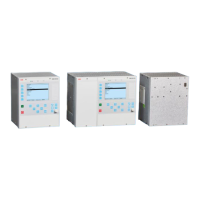1MRK 505 353-UEN Section 6
BP-Additions to base documentation
Application Manual 49
Bay protection functions REB500
6.3.2.2 Additions to an existing station
When adding bay protection to an existing station more checks have to be carried
out than is the case of a REB500 with only station protection. To avoid any risk of
the station protection functions (BBP, BFP and EFP) being affected and possibly
mal operating when performing the additional checks, the following procedure is
recommended. The basic philosophy is to check the bay unit on its own first (with-
out the rest of the REB500 system). This is done in the stand-alone bay unit mode
and requires that the setfile be loaded in the bay unit to be extended beforehand as
follows:
Step 1
Interrupt the optical fiber link between the central unit and the by unit to be com-
missioned.
Step 2
Switch on the auxiliary supply to the new bay unit.
Step 3
Appropriately update the setfile of the REB500 in question to include the new bay
unit (activate the feeder) and download it to the new bay unit. The setfile must
include all the settings needed for the new bay unit.
Step 4 (Check of the analogue inputs)
Refer to REB500 Commissioning Manual Sections “Checking the analog inputs
(CTs)” and “Checking the analog inputs (VTs)”.
Measuring the start values of BP functions (e.g. distance protection function) is un-
necessary, because they are fully processed by the software and any error would be
detected by the self-supervision function. However, it is normal to measure the re-
actances of the various distance measuring zones. This may be omitted if a suitable
test set is not available.
Step 5 (Check the binary inputs and outputs)
Refer to REB500 Commissioning Manual Sections “Checking the binary input sig-
nals”, “Checking the aux. contacts of isolators and circuit breakers” and “Checking
the binary output signals”.
Step 6
Block the REB500 system (e.g. using “Block output relays” on the central unit).

